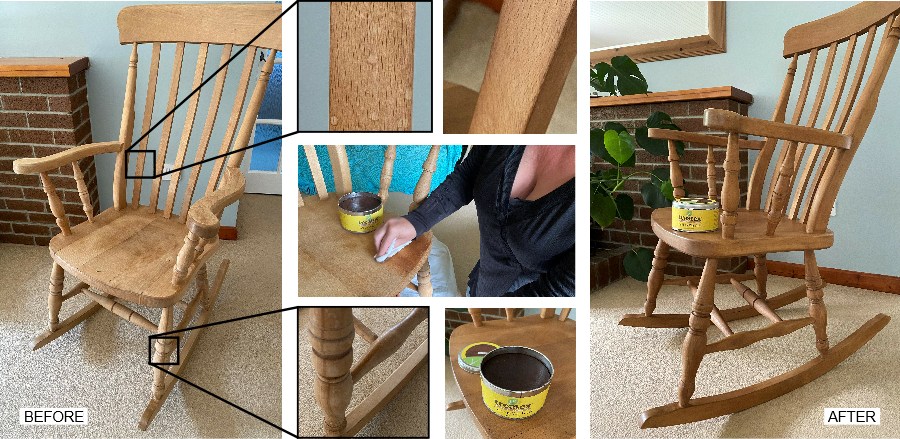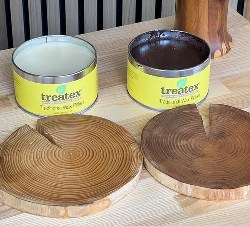How to Wax Furniture
Posted by Morag, Celtic Sustainables on 23rd Aug 2023
I have been looking for a traditional wood wax polish to give our wooden rocking chair a bit of love. I decided to try the new Traditional Wood Wax finish from Treatex on this much-cherished piece of furniture.
This furniture wax polish is made from five natural waxes with a synthetic isoaliphate solvent. The isoaliphate is a de-aromatised and non-toxic solvent. Ideal if you are allergic to turpentines or orange oil (which are often used for the same purpose in other furniture waxes). The non-toxic solvent helps keep the wax polish soft during application and aids in drying the wax once it’s been applied to the wood. Because it is de-aromatised it has very little smell.
Treatex Traditional Wax Polish smells faintly of a cross between beeswax and Smarties (yes! the children’s chocolate confectionery) to me.
Coloured Wax for Wood or Clear?
Available in two colours; clear and dark brown. I chose the coloured wax for wood in dark brown to try and darken the existing natural beech colour of the rocking chair to something that fitted more closely to the other wooden furniture in the room.
Incidentally, the clear version does not “fire” or darken the colour of lighter timbers. I tried a patch of both on the underside of the beech seat and, although the Clear version did darken the wood during the application, after it was dry the wood returned to its natural colour.
How to Wax Furniture
Preparation
The water stains on the wooden rocking chair were a testament to the fact that it hadn’t received much attention since its purchase over 20 years ago. It had spent some years in the kitchen where it had been used as a lazy rack to dry tea towels amongst other wooden furniture use horror stories (like being placed in front of a full-height, full-sun window).
To get rid of the numerous water stains on the wood, and because we didn’t know what the surface had been treated with previously, I decided to give the rocking chair a sand with 120 grit sandpaper before applying the wood wax. This also had the added benefit of creating a good clean surface.
How to apply soft wax polish to wooden furniture
After sanding and ensuring all surfaces were dust free, I applied the soft wax with a lint-free cloth along the grain of the wood. I worked the dark brown wax methodically into each surface making sure I blended in the edges, so no area was darker or lighter than the other.
I found when the wood didn’t take the wax so easily (maybe because of the difference in wood grain or absorbency), that simply leaving the wax on for a little longer before blending helped to create the uniform colour I wanted.
The decorative side spindles were more difficult to apply the wax to along the grain, however doing around the spindles with the cloth ensured that the wax was applied into all the wooden spindle coves, beads and other nooks and crannies.
The wax was dry within about 2 hours on this sunny warm day. One coat of dark brown wood wax polish was enough for me to create the darker surface I desired. I decided not to polish the wax once it was dried. I was very happy with the matt finish that the simple application had achieved. If I had decided to buff the wood wax, I would have created a slightly shinier, slightly more slippery surface.
The surface, once dry, was not slippery or sticky and had not raised the grain of the wood in any way. The wax had disappeared into the grain of the wood to nourish and protect it. The pigmentation of the dark brown wax had blended in with no streaks or obvious lines.
I know that the mixture of natural waxes will nourish and protect the wood for years to come. The surface is now somewhat moisture-resistant. I have however moved the rocking chair away from the tea-towel drying temptation.
Traditional Wood Wax Product Details
Treatex Traditional Wax Polish is made from five natural waxes (Candelilla Wax, Carnauba Wax, Montan Wax, Microcrystaline Wax and Beeswax) It also contains Isoaliphates (ade-aromatised, non-toxic solvent) to help it dry faster and the dark brown version has Iron Oxide Pigments to create that depth of colour.
You can expect it to cover 7.5m2 to 10m2 per 500g tin. Certainly this project hardly touched the tin!
Traditional Wax Polish is perfect for use on wooden furniture, doors, panelling, beams and wooden carvings and can also be used to treat stained timbers. It helps protect against the effects of central heating and offers some moisture resistance.
If you require a water resistant finish on interior wood, I'd recommend the Treatex Hardwax Oil Ultra or Classic Colour products - see this blog post about a wooden table makeover.





